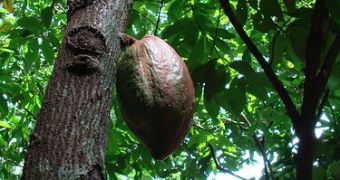An international team led by Claire Lanaud of CIRAD, France, and Mark Guiltinan of Penn State, sequenced and analyzed the genome for the Criollo variety of the cacao tree, considered to be the source of the finest chocolate in the world.
The team which also included scientists from 18 other institutions, not only sectioned the genome of this very ancient plant, but also put together 76% of the genome, relating 82% of those genes to the 10 cacao chromosomes.
This analysis discovered a diversity in gene families that could strongly impact future cacao trees and fruit, by providing protection against insects and fungal diseases or by improving their properties.
The Criollo variety of the cocoa tree was the first to be domesticated, 3,000 years ago, when cocoa production began in Mesoamerica.
Siela Maximova, associate professor of horticulture and a member of the research team, said that “relics of the ancestral Criollo first cultivated by Olmec or Maya people can still be encountered in old Mesoamerican plantations or in forests where the Maya live.
“Our genome sequence is derived form a Belizean Criollo plant collected in the Mayan mountains.”
As these cocoa trees self-pollinate, they are usually highly homozygous, which makes them a perfect choice for a precise genome assembly.
“The large amount of information generated by this project dramatically changes the status of this tropical plant and its potential interest for the scientific community,” said Guiltinan, who is a professor of plant molecular biology.
He added that “Theobroma cacao is the first early domesticated tropical tree fruit crop to be sequenced.
“Interestingly, only 20 percent of the genome was made up of transposable elements.”
These elements also called transposons, are one of the natural pathways that change genetic sequences and they do it by moving around the chromosomes and changing the order of the gentic material.
Scientists say that smaller amounts of transposons than normal could lead to a slower evolution of the chocolate plant.
Even though these cacao trees - Theobroma cocao, were a new-world crop, they are now grown and cultivated in humid tropical areas worldwide.
The researchers are interested by certain gene families that could link to qualities and diseases specific to cocoa, and they hope that by mapping these gene families, they will discover genes that will prove useful for plant breeding programs.
“We hope this achievement will encourage greater investment in research of Theobroma cacao, the 'food of the Gods' whose magic flavor has spread worldwide since the time of the Maya and Aztec civilizations, and whose continued study will benefit developing countries for which cocoa is of high economic importance," Guiltinan said.
Every year, nearly 3.7 million tons of cocoa are produced worldwide.

 14 DAY TRIAL //
14 DAY TRIAL //